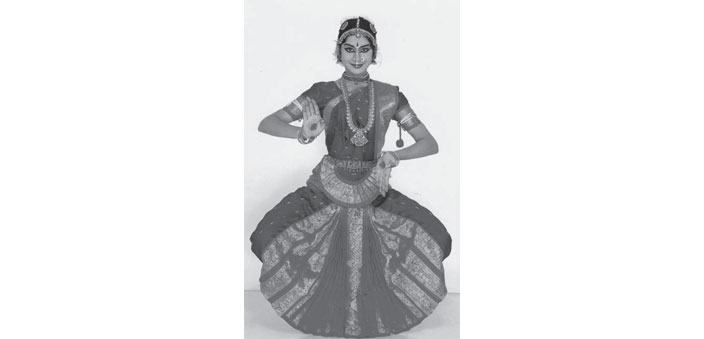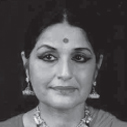Bharata Natyam is the glorious dance style from the southern state of Tamil Nadu. One cannot hazard a guess as to when it arose out of the soil of the Dravida culture. One finds references dating from the first few centuries of the Christian era to a very vigorous system of dance and music being practiced at the highest professional level in the Dravida country.
The earliest reference to systematised dance referred to as kuttu, is to be found in the great Tamil epic Shilappadikaram, written in all probability in the 3rd or 4th century A.D. It is a treatise on the three-fold classification of the Tamil language – literary Tamil, music and drama. It is however clear that this epic comes later than the Natyasastra, since it shows an awareness of the Natyasastric practices.
It appears that earlier, in the pre-historic era, dances were performed to propitiate deities or for ritualistic purposes. But during the times of the Shilappadikaram, it appears, dances were performed for secular purposes also. This appears to be due to the influence of the Natyasastra. The Shilappadikaram is a literal storehouse on the position and practice of dance and music of that era. There are specifications for the guru, music teacher, the mridangist, the composer of songs, the flautist, the player of the yaal (forerunner of the veenaa) etc.
It may not be wrong to conclude that for dancing at least, Bharata may have turned to the South.
Today’s Bharata Natyam is the end product of this great tradition. It had several names like Chinna Melam, Sadir, Dasiattam etc. It was also called “Bharatam” not after sage Bharata; rather the term is derived from three essential facets of the style: “Bha” from “bhava” (mental state or emotion). “Ra” from “raga” (musical mode) and “Ta” from “tala” (time measure).
Evolution of the dance form
Traditionally, it was the proud privilege of the dancing girl “Devadasi” (servant of God) to practice this glorious art. The roots of this system can be traced all over the country, but the system appears to be of a special significance in the South.
Indian history provides many references to the practice of dedicating girls to the dancing tradition – the girls being referred to as “ganika” in the North and “kuttiyar” or “virali” in the South. The Natyashastric tradition mentions that “natya” (inclusive of dance and music) is to be performed for the entertainment of the king and then his populace. In the Indian tradition, God is the greatest king and thus he also should be entertained, and what better way can there be but “natya”? Thus right through the history of formal worship in India there has been a community of devadasis attached to temples and one of the principal functions of these devadasis was to dance before the deity of the concerned temple. Each region of the country had their own temples as well as cultural ethos. These devadasis were servants of God but they were also great scholars, great experts of their art and despite adverse conditions, it is they and their great spirit which have perpetuated this art.
Bharata Natyam is designed as a votive offering to be placed at the feet of the lord. As such it must be remembered that most of the items are either religio-philosophical in nature or are in the form of straight forward bhakti lyrics in praise of the glory of the lord. But it also has items which are secular in nature. It is intended as a solo presentation but may have more than one dancer occasionally.
Technically Bharata Natyam has a judicious blend of both nritta and nritya. The basic and fundamental unit of nritta is the adavu. It is composed of an opening or basic posture which is followed by a combination of steps and movements. Each adavu has its own rhythmic syllables to which it is danced; the syllables are called shollus. In fact many of the adavus are named after their individual shollus. The Bharata Natyam technique lays great stress on the very correct and well defined lines that the entire body specially the torso and the arms have to be maintained. The erect and upright positions of the torso, the elegant stance of the shoulders thrown back give it an angularity which is crisp, at the same time attractive. Nritya in Bharata Natyam of course uses the rasas specified by Bharata. For hastas (hand gestures) it follows the Sanskrit text “Abhinayadarpana” by Nandikeshvara.
The musical mode is classical Carnatic with its elaborate tala system. The songs and lyrics for nritya items are, by and large, selected from the writings of the South Indian saint-poets, the Tanjore quartet and some contemporary poets.
The aharya (costumes) is usually uniform since it is a solo dance. No matter what sort of a character the solo dancer is portraying there is no change in the costume. By and large the costume worn today is stitched. The jewellery that is worn by the Tamil brides – appropriate for the bride of God, the devadasi.
Repertoire
- Alarippu: This is the opening item which is a nritta item. Note: Alarippu can be sometimes preceded by an item called Todaymangalam or Pushpanjali. Todaymangalam is quite often than not followed by an item called “Kautvam”.
- Jatisvaram: This again is a nritta item. It is a combination of jatis (string of adavus) danced to the svaras of a raga.
- Shabdam: A nritya item which makes use of the sattvika abhinaya for the first time in a recital. It is addressed to the deity and expresses spiritual love.
- Varnam: An intricate and complex item which is a blend of both nritta and nritya.
- Padam: A pure nritya item. It is a devotional song depicting the spiritual love of a bhakta for his deity.
- Javali: Yet another variety of nritya composition which is usually secular in character. It usually represents the love of a nayika for the nayaka.
- Tillana: A pure nritta item performed as the concluding offering in a Bharata Natyam recital.


